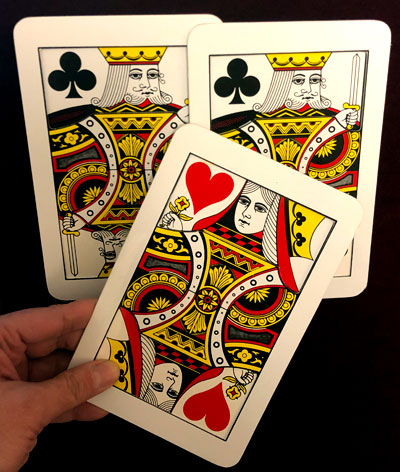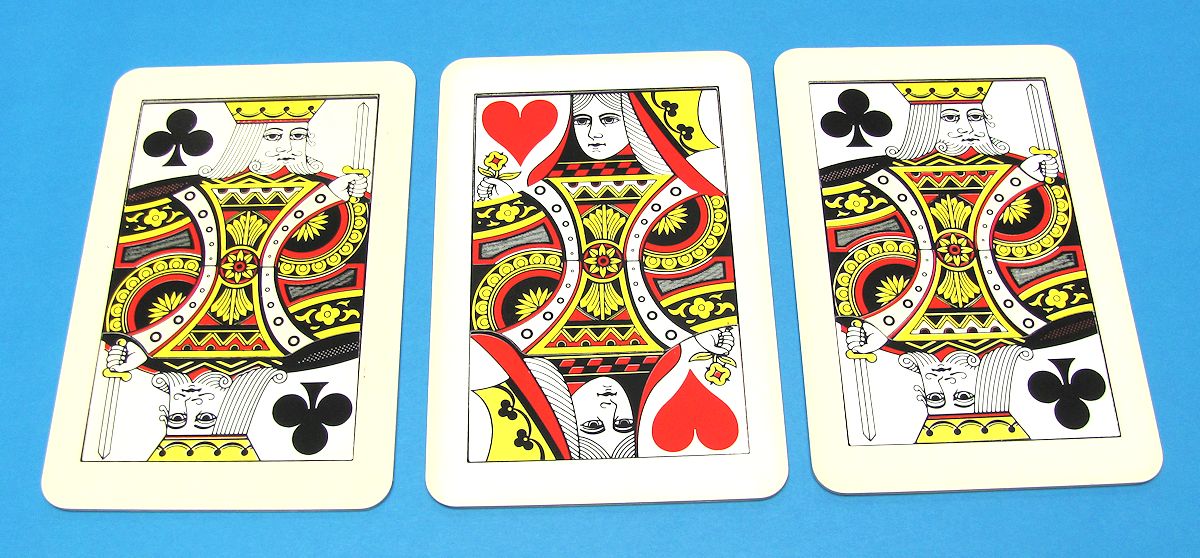THREE CARD MONTE / COLOR MONTE

Three Card Monte, or Find the Queen is a classic chance game! Can you randomly select the card hiding the queen? It's a 1 in 3 chance of choosing the right answer! A free online version of 3 Card Poker with 6-card Bonus. Test out your 3 Card Poker strategy here. Practice for Vegas. Play Three Card Poker for Free. Three-card Monte is most often played with cards, but sometimes with shells. The ‘mark’ is supposed to find a particular card, or perhaps a pea hidden under a shell. If the victim does not select the right card or shell, he loses and must pay the suspect money. Sometimes, people choose to partake in this game, thinking they may actually win. In Three Card Monte the crew of the Hummingbird is back. When we saw them last they had just completed a “complicated con for the Andromeda Royal Family.” Now they are drawn into another con and Roy, Dee Dee, Dr. Wufren, Doven, Kyle, Bullfrog, Ciarissa and Willy are all back in action. Three Card Monte is the American name for it. In Britain it is usually called Find the Lady, and the equivalent French game is Bonneteau. The appearance of the game is simple.

Con Games & Conjuring – Don’t Bet on It! Three Card Monte
I love the Monte! It is seemingly an honest game of chance but is, in fact, a con game where those who unwittingly are suckered into placing a bet have almost no chance at winning. The game is fixed; it’s rigged. The operator (the person hosting the game and manipulating the props) is cheating by employing specialized apparatus or utilizing covert sleight of hand methods to create the illusion of a fair game. For centuries the monte in all its forms whether using 3 thimbles or walnut shells and pea, a ball and cups, bottle caps, or cards – has been used to swindle many poor victims from their hard-earned cash.

The concept is simple, usually 3 objects such as playing cards are used. One of the objects is different from the others – say one red face card like the Ace of Hearts is mixed face down on a table with two black face cards such as the Two of Clubs & Three of Clubs. The task is to follow and find the one odd card, the Ace of Hearts, amidst the two similar cards while their faces remain hidden. If you do this, you win! But the game is much more difficult than you could imagine because the operator cheats!
With the public’s interest in gambling over the centuries, it is no surprise that many so-called games of chance have found their way into the repertoire of magicians who have learned how to manipulate those games and the paraphernalia involved to achieve a desired outcome – that is… to win or at least prevent you from winning. Thankfully, most magicians now perform these routines as an expose’ of how others can protect themselves from being cheated by these crooked games. Uk football betting.
Three Card Monte was a favorite trick of legendary magician Michael Skinner. For 20 years, he enjoyed demonstrating his incredible variation at the Golden Nugget casino in Las Vegas. The routine he performed made use of some cleverly designed playing cards created by Theodore Deland. These are the same ingenious cards supplied in Theatre Magic’s version of Three Card Monte. Micheal Skinner fooled thousands of people into believing he was using incredible sleight of hand skill to manipulate the cards, but the cards themselves did most of the work!
Here is Bill Malone performing his hamdling of the Skinner routine
For those who wish to learn some sleight of hand to perform the three card monte, Theatre Magic has you covered! One of the biggest selling packet card tricks in magic based on this classic gambling plot is Color Monte, marketed by Emerson and West in 1974 with a fantastic surprise ending created by Jim Temple. The inspiration for Jim Temple’s Color Monte was Bill Elliott’s 3 Card Monkey Business which was published in the March 1959 edition of P. Howard Lyon’s Ibidem. Elliott’s routine was based on Ed Marlo’s Quick 3-Way which was published in the December 1958 edition of the same journal.

Although the Color Monte cards are unique, they are not gaffed – in that the effect is achieved through sleight of hand alone. In fact, the Color Monte cards may be examined at the conclusion of the demonstration and the trick, once learned, can indeed be performed with ordinary playing cards. However, I personally feel that performing the effect with regular playing cards diminishes the impact of Jim Temple’s incredible surprise ending.
I shall refrain from naming the specific sleight used in the Color Monte routine, nor will I describe its mechanics, but I will provide a brief history of the technique so that those ambitious few may research it further. The primary sleight of hand maneuver employed in the Color Monte routine has erroneously been attributed to Dai Vernon in the first volume of The Vernon Chronicles in the discussion at the end of the effect, The Two-Thirteen Trick, page 154. It was believed that Dai Vernon devised this clever maneuver in 1933. However, the move in question has been more commonly associated with the magicians, Henry Christ and Ted Annemann. The latter having probably first described its application to playing cards in an effect entitled Remote Control which was marketed in 1931. The ACTUAL move first saw the light of day via a gentleman named Burling Hull (of Svengali Deck notoriety) – who used it as an envelope switch in a book entitled ’50 sealed message readings’ – published by Davenports in the late 1920’s.
While both Color Monte and Three Card Monte follow similar plots, they differ significantly in presentation. Three Card Monte can be presented almost as if you were truly playing the game or, as I prefer, instructing folks as to how the game is played. Color Monte is more of a story-telling routine in which you share an experience you apparently had upon encountering this game yourself while using the cards to illustrate what happened. I find the Three Card Monte plays very well for adult audiences who can actively follow the cards positions in a scenario where you have some table space to lay the cards down. Color Monte is great for children and family audiences to enjoy as it features shapes and colors on the cards rather than actual numbers and suite symbols so it tends to be easier to follow, not requiring any significant amount of thought on the part of the audience and the handling can be performed mainly in the magician’s hands so that a table is not necessarily required. So, the Three Card Monte may be better suited for a seated performance or one in which you can utilize a table whereas Color Monte is ideal for strolling situations. I always carry both with me in my professional work so that I am prepared for any situation at a moment’s notice. This classic con game has peeked the curiosity of many ambitious individuals willing to take a chance. If you are willing to take a chance to add something uniquely appealing to your repertoire, I can guarantee the monte will be one of the most popular effects you can perform.
Michael Matson 2018
Three card monte is a con game similar to the shell game. It involves a set of three cards and usually a gamble of an amount of money. In three card Monte, a con man, known as an inside man, tricks a victim, known as a mark, with the help of an outside man. The trick is often executed on an unsuspecting mark through a sleight of hand by the inside man. It is also known as triples, three-card marney, three-card shuffle, and three-card trick.
Three Card Monte Magic Trick

A confidence game, three card monte is best performed when the mark gains confidence in his ability to win, or confidence in an outside man. The outside man is usually an accomplice of the inside man, a fact unknown to the mark.
Three Card Monte Magic Trick
All star slots instant play. Three card monte is played with three playing cards. Any cards can be used, though aces and queens are popular choices. The ace of spades, a card favored by many, is a card often used by dealers because of its lucky connotations. Accompanying cards may also be any cards, though they are also usually face cards, and a different face than the target card.
The 'game' is performed when the dealer shows the mark the target card. It is then placed faced down on a table with the other two cards and shuffled on the table, in sight. The mark must then identify the face down target card correctly to win the game and the bet. However, through the sleight of hand, the card thought to be the target card by the mark is revealed as wrong, and the stakes are lost.
A three card monte game relies on the act of other people as well as the tricks of the inside man. The games are often performed on streets and in basements or bars by a dealer with friends. The friends pretend not to know the dealer, and act as winners or losers in the three card monte game. Winning will increase the confidence of the unsuspecting mark and losing will make the mark think he can outperform the losers in what seems to be an easy task.
The most popular type of three card monte trick used by the dealer to fool the mark is “the throw.” The throw is executed by a sleight of hand in which the selected card is revealed wrongly to the mark. When the mark picks a target card that he believes has won him the bet, the dealer picks up all three cards, two with one hand, and one card with the other hand. The hand with two cards must include the one chosen, which is generally the correct target card.
Three Card Monte
A losing card is picked up face down, and then a winning card is picked up face down with the same hand. The winning and chosen card should now be under a losing card. The dealer then flips the top losing card from his hand, face up unto the table. The trick is for the dealer to give the illusion that it was flipped from the bottom, and was therefore the card that was chosen. But the top card was a losing card, and the winning card remains in the dealer’s hand. The mark has lost the bet and is none the wiser.